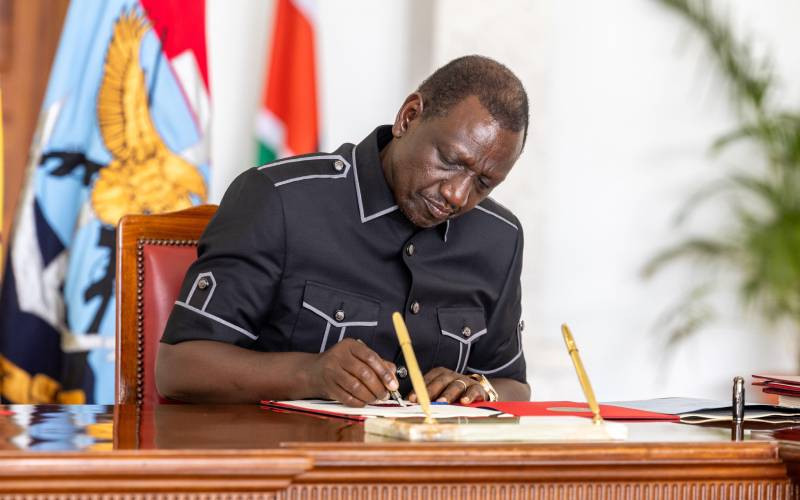By Mahanda Indakwa
For all his spectacular achievements, critics still blame Dr Richard Leakey for not training his middle level managers or preparing a succession plan at the Kenya Wildlife Service.
These two oversights had a deleterious impact on the organisation in later years in terms of capacity and structure, with much smaller organisations like the National Museums of Kenya and Kenya Forest Service boasting bigger brainpower than the better-endowed KWS.
Leakey’s exit brought in Dr David Western, a Tanzania-born but Kenyan raised and University of Nairobi trained wildlife ecologist. An articulate scientist who wrote his own speeches, preferred carrying out field research rather than sitting in an office and was ill at ease in a suit, he ran quickly into trouble. His detractors accused him of focusing unduly on wildlife outside protected areas (in Western’s view, 75 per cent of Kenya’s wildlife is outside parks) and neglecting wildlife protection, deemed the core of conservation under Leakey. Donors kept off and in the ensuing financial crunch worsened by the 1998 El Niño deluge and the infamous Likoni tribal clashes that saw tourists give Kenya a wide berth, he was edged out of office.
But it is perhaps only under Western’s reign that KWS was strategically organised to manage wildlife scientifically. The wildlife fraternity was at that time split into two sharply discordant ideological groups; those supporting a strict protectionist regime centred around parks and those keen on making the land outside parks the focus of conservation. His was the age of experimentation, of ‘parks beyond parks’, of eco-tourism and community owned wildlife sanctuaries and group ranches. He was peering deep into the future, to a time when loss of migration corridors and wildlife dispersal areas would render parks unable to function on a sound ecological basis. He is perhaps the only wildlife chief who dared to dream, and his opponents derisively called him one.
The period under Leakey, who served twice, and Western (and later Nehemiah Rotich) could be hailed as the finest for KWS. In these three men, Kenya’s wildlife had a voice that resounded globally, one it sadly lost — perhaps permanently — when they exited the scene. Leakey and Western never saw eye to eye ideologically and it is curious why the two eminent thinkers never realised that neither was wrong but both were right.
Perhaps what Kenya needed, and still does is, a combination of what the two advocated individually: Sound management of parks and reserves (Leakey) running in tandem with the safeguarding of habitats on community-owned land outside parks (Western).
Curiously, two directors who served some of the shortest stints had significant impact on conservation policy. Career game warden Michael Wamithi put an end to an amorphous wildlife-cropping project, which skeptics complained was abused by select large landowners to camouflage sport hunting, banned in 1977.
His successor Evans Mukolwe, later dismissed for hiring rangers without government approval, initiated the enactment of a new wildlife law, a process that has dragged on since 2004. It is also Mr Mukolwe who convinced government to increase funding to KWS, with 400 elephants translocated from Shimba Hills to Tsavo East National Park without a single coin from donors, or the assistance of pesky foreign ‘experts’ as had been the case previously.
Since 2004, the biggest debate has been: Should a conservationist or a management expert manage KWS? Should the organisation be run as a service or a business? These questions were relevant because KWS became horribly (dis)organised internally, often broke, the staff bloated and demoralised, its human resource management structures haphazard. So when Dr Julius Kipng’etich took over, his became a study in management science, with KWS becoming ‘more corporate’. But his critics in the service claim that it is on his watch that that the institution became ‘top heavy’, poaching escalated to the 1980s levels and discipline and morale within the ranger cadre nosedived.
But one common denominator throughout 50 years of independence is that conservation operates with the dearth of knowledge that plagued pioneer game wardens of the 1940s. Research capabilities are still appalling, with most wildlife research stations underfunded, underequipped and poorly staffed. Government has abdicated its responsibility to the extent that foreigners have studied our national parks better than we ever will.
The heated wildlife debates of yore are no more, except for puerile, activist arguments on social media charged with emotion and often bereft of facts or historical grounding. Whereas a Wildlife Conservation and Management Bill lies before Parliament, our ecologists, both in government and academia, haven’t bothered to publicly argue the merits and demerits of this law (it would bore Kenyans, who only debate politics and football, to death anyway).
Fixated as we are with poaching, we still talk about communities ‘co-existing with wildlife’, the same communities who suffer injuries, deaths and crop damage when wild animals strike. Because we have left the thinking to romantics who think wild animals are ‘beautiful’, we naively hope that throwing a small eco-tourism project at communities will make them tolerate wildlife.
We are blind to the realities of poverty and population growth, the large herds of cattle that swarm our national parks each dry season, the ravages of climate change, the drying of rivers and loss of wildlife corridors and dispersal areas to pastoralists-turned farmers fed up of suffering human-wildlife conflict while others milk the tourism cow. Yet KWS is better equipped today than its predecessors ever were. Conservation NGOs, many with nothing to show for their ‘donor support’ to KWS apart from newspaper cuttings, colourful and content-laden websites and never-ending workshops, abound as compared to 1946 when none existed.
But our habitats are declining and animals dying — while decision makers worry about poachers. Will we have wildlife in 50 years? Who knows? But as the Government plans to merge KWS and Kenya Forest Service into the Kenya Wildlife and Forest Service, let it not be a case of history repeating itself.
Stay informed. Subscribe to our newsletter
 The Standard Group Plc is a
multi-media organization with investments in media platforms spanning newspaper
print operations, television, radio broadcasting, digital and online services. The
Standard Group is recognized as a leading multi-media house in Kenya with a key
influence in matters of national and international interest.
The Standard Group Plc is a
multi-media organization with investments in media platforms spanning newspaper
print operations, television, radio broadcasting, digital and online services. The
Standard Group is recognized as a leading multi-media house in Kenya with a key
influence in matters of national and international interest.
 The Standard Group Plc is a
multi-media organization with investments in media platforms spanning newspaper
print operations, television, radio broadcasting, digital and online services. The
Standard Group is recognized as a leading multi-media house in Kenya with a key
influence in matters of national and international interest.
The Standard Group Plc is a
multi-media organization with investments in media platforms spanning newspaper
print operations, television, radio broadcasting, digital and online services. The
Standard Group is recognized as a leading multi-media house in Kenya with a key
influence in matters of national and international interest.








